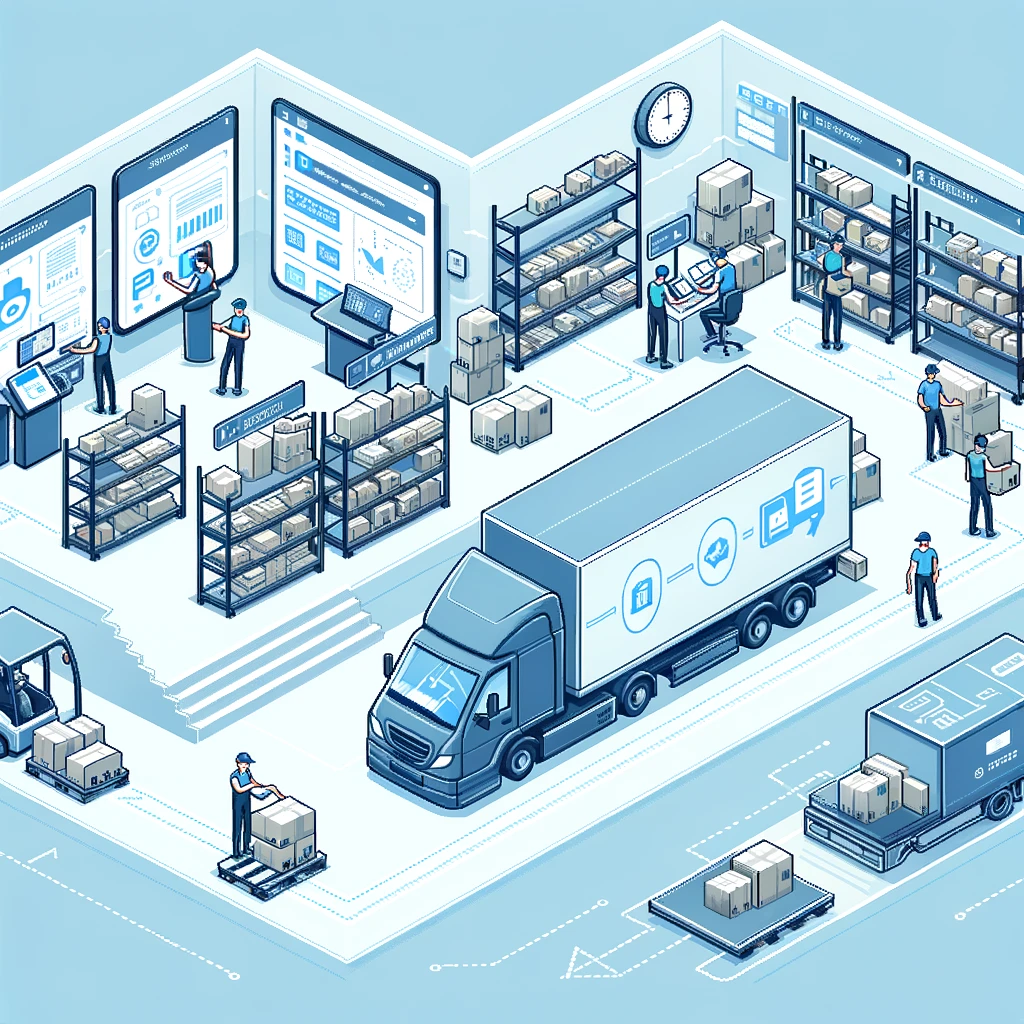Introduction

Welcome to the dynamic world of e-commerce in Columbia! As local businesses explore new frontiers in the digital marketplace, it’s an exciting time to consider the vast opportunities that online sales can offer. Whether you’re a seasoned retailer or just starting out, understanding the benefits and challenges of e-commerce is crucial for your business’s growth and sustainability.
Columbia’s retail landscape is undergoing a transformative shift. Traditional brick-and-mortar stores are now extending their reach beyond local neighborhoods to connect with customers across the country—and potentially around the world. The integration of e-commerce allows your business to remain competitive and relevant in today’s fast-paced market.
Why E-Commerce?
- Wider Reach: Unlike a physical store, an online platform allows you to engage with customers far beyond your immediate locality.
- Convenience: Customers can browse and shop your products at any time of the day, enhancing customer satisfaction and boosting sales.
- Cost Efficiency: Operating online can reduce overhead costs like rent and utilities, allowing you to invest more in product development and marketing.
Here’s a quick look at how the e-commerce adoption rate among local retailers has grown over the past few years:
| Year | % of Retailers Adopting E-Commerce |
|---|---|
| 2018 | 25% |
| 2019 | 35% |
| 2020 | 50% |
| 2021 | 65% |
| 2022 | 75% |
As you can see, the trend is clearly pointing towards digital transformation. This blog series will guide you through each step of integrating e-commerce into your business, ensuring you make the most out of your online presence.
Let’s dive into the fundamentals of e-commerce and explore how you can harness its power to propel your business into a prosperous future.
Understanding E-Commerce Fundamentals

Embarking on your e-commerce journey starts with grasping the basics. What exactly is e-commerce? Simply put, it refers to the buying and selling of goods and services over the internet. It ranges from a simple transaction between two individuals to complex interactions between businesses. Here, we’ll break down the fundamentals to help you understand how e-commerce can be leveraged to benefit your Columbia retail business.
Key Components of E-Commerce:
- Online Storefront: This is where your products or services are displayed. It’s your digital shop window.
- Shopping Cart: Allows customers to save their selections before proceeding to checkout.
- Payment Gateway: Securely processes payments from customers.
- Customer Service: Digital support for your customers’ needs before, during, and after a purchase.
E-Commerce Models: Understanding different e-commerce models can help you determine the best approach for your business. Here’s a brief overview:
| Model | Description |
|---|---|
| B2C (Business-to-Consumer) | The most common model, where businesses sell directly to consumers. |
| B2B (Business-to-Business) | Involves selling goods or services between businesses. |
| C2C (Consumer-to-Consumer) | Facilitates transactions between consumers, often through a third-party platform. |
| D2C (Direct-to-Consumer) | Manufacturers or creators sell directly to consumers, bypassing traditional retailers. |
Why It Matters:
- Reach & Engagement: By moving online, you can reach more customers than you could with just a physical store.
- Operational Efficiency: E-commerce automates many processes (like orders, payments, inventory management) which can save time and reduce errors.
- Customer Insights: Online tools and analytics can provide valuable data about your customers’ preferences and behaviors, helping you make informed business decisions.
Challenges to Consider:
- Technical Barriers: Setting up an e-commerce platform requires some technical knowledge.
- Security Concerns: Ensuring safe transactions is crucial for maintaining customer trust.
- Market Saturation: Standing out in a crowded online market requires effective marketing and unique selling propositions.
By understanding these fundamentals, you can build a strong foundation for your e-commerce venture. Remember, the goal isn’t just to go online, but to thrive there, enhancing your business’s growth and customer reach. As we move forward, we’ll delve deeper into choosing the right e-commerce platform, which is pivotal in building your online presence effectively.
Choosing the Right E-Commerce Platform

Selecting the right e-commerce platform is a critical decision for any Columbia retailer ready to dive into the digital marketplace. Think of it as choosing the location and layout of a physical store—it needs to be accessible, attractive, and functional. With a myriad of platforms available, it can feel overwhelming to pick one. Don’t worry! We’ll walk through some key factors to consider that will help simplify your decision.
Key Factors to Consider:
- Ease of Use: Look for a platform that you can manage easily. A user-friendly interface will save you a lot of time and frustration.
- Scalability: As your business grows, your platform should be able to grow with you. Ensure it can handle increasing traffic and more product listings without performance issues.
- Cost: Budget is always important. Consider the initial setup costs, monthly fees, and transaction fees. Also, factor in any additional costs for plugins or third-party services.
- Features: Identify the features essential for your business. This includes SEO capabilities, mobile responsiveness, customer support tools, and integration options with other systems.
- Support: Good customer support from the platform provider is crucial. You want to ensure that help is available whenever you need it.
Popular Platforms: Here’s a quick comparison of some popular e-commerce platforms that are well-suited for different business sizes and needs:
| Platform | Best For | Key Features |
|---|---|---|
| Shopify | Ease of use, all-in-one | Extensive themes, full support |
| WooCommerce | Flexibility, WordPress users | Highly customizable, free base software |
| Magento | Large businesses, scalability | Powerful, feature-rich, highly scalable |
Choosing the Right Fit:
- Shopify might be the go-to if you’re looking for simplicity and an all-in-one solution. It’s particularly friendly for beginners.
- WooCommerce is ideal if you’re already familiar with WordPress and need a customizable platform with a wide range of plugins.
- Magento offers extensive features and scalability, making it suitable for larger businesses with specific needs and the resources to manage a more complex system.
Takeaway: The best platform for your business depends on your specific needs, skills, and goals. Consider starting with a trial or demo if available, to get a firsthand experience before making a commitment. This way, you ensure the platform you choose not only meets your current needs but also supports your future growth.
Next, we’ll look into the best payment gateway options, which is another pivotal aspect of setting up your online store successfully.
Digital Payment Solutions

When it comes to e-commerce, having a seamless and secure payment process is key to winning and retaining customers. As you expand your Columbia-based retail business online, understanding the various digital payment options available is crucial. This will not only enhance the customer experience but also ensure efficient transaction processing.
Why Digital Payments? Digital payments offer speed, convenience, and security. They allow your customers to make purchases easily without the barriers of cash or checks. Additionally, they provide your business with faster access to funds, streamlined accounting, and a reduction in handling costs associated with physical money.
Popular Payment Methods:
- Credit and Debit Cards: These are the most commonly used payment methods online. They are widely accepted and offer consumer protection.
- Mobile Payments: Apps like Apple Pay, Google Wallet, and local apps like Nequi in Columbia provide a convenient option for customers to pay directly from their mobile devices.
- Online Banking Transfers: These are direct transfers from a customer’s bank account to the business account, often used for larger transactions.
- Payment Gateways: Services like PayPal, Stripe, and PayU allow businesses to accept a variety of payment methods through a single channel.
Choosing the Right Payment Solution: The choice of payment solutions depends on your specific business needs, customer preferences, and the technical integration capabilities of your chosen e-commerce platform.
Here’s a quick overview of some options:
| Payment Method | Pros | Cons |
|---|---|---|
| Credit/Debit Cards | Widely used and trusted | Fees can be high |
| Mobile Payments | Fast and convenient | Not all customers use mobile wallets |
| Online Banking | Secure for large payments | Slower processing times |
| Payment Gateways | Versatile and secure | Integration and service fees |
Implementing Your Payment System:
- Security: Ensure that whichever system you choose complies with local and international security standards like PCI DSS to protect sensitive customer data.
- Customer Experience: Opt for systems that require minimal input from the user, reducing friction at checkout.
- Integration: Your payment system should integrate seamlessly with your e-commerce platform to provide a smooth transaction process.
By providing a variety of payment options, you cater to different customer preferences, enhancing their shopping experience and potentially increasing your conversion rates. In the next section, we’ll explore logistics and fulfillment strategies to ensure your products reach your customers efficiently after they’ve made their purchases.
Logistics and Fulfillment Strategies

In the world of e-commerce, getting your products to your customers efficiently and on time is as crucial as any digital strategy. Effective logistics and fulfillment are the backbone of customer satisfaction and can significantly impact the reputation of your online store. Let’s explore some strategies to ensure your logistics are as streamlined as your website.
Key Elements of E-Commerce Logistics:
- Warehousing: Proper storage solutions ensure that your products are kept safe and organized. Consider the location of your warehouse to minimize delivery times.
- Inventory Management: Keeping track of what’s in stock, what’s running low, and what’s on backorder is essential to prevent overselling and to keep customers informed.
- Order Processing: Efficiently handling orders from receipt to shipment is key. Automation can help speed up this process.
- Shipping and Handling: Choosing the right shipping partners and methods can make a big difference in delivery times and costs.
- Returns Management: Having a clear and straightforward return policy and process is vital for customer trust and retention.
Choosing the Right Partners: Your choice of logistics partners can make or break your e-commerce operation. Consider the following when choosing a partner:
| Criteria | Why It Matters |
|---|---|
| Reliability | Consistent and timely deliveries build trust with customers. |
| Coverage | Ensure they cover all your target delivery areas. |
| Cost | Competitive pricing is essential for maintaining margins. |
| Technology | Tracking and management systems enhance transparency. |
| Customer Service | Quick responses to queries and problems improve satisfaction. |
Implementing Your Strategy:
- Technology Integration: Use software that integrates with your e-commerce platform for real-time inventory and order updates.
- Scalability: Your logistics should be able to scale during peak periods like holidays or sales events without compromising on delivery times.
- Communication: Keep your customers updated at every step of the delivery process. Automated emails or SMS for order confirmation, dispatch, and delivery can enhance the customer experience.
Remember, the efficiency of your fulfillment process is often as important as the quality of the products you sell. Customers expect fast, reliable service, and meeting these expectations can set your business apart in a crowded marketplace. In the next section, we will delve into the legal and regulatory considerations to ensure that your e-commerce business complies with local laws and regulations, providing a safe and reliable shopping experience for your customers.
Legal and Regulatory Considerations

Stepping into the world of e-commerce not only involves setting up a store and selling products but also navigating the maze of legal and regulatory requirements. Understanding these legal aspects is crucial to ensure that your online business operates smoothly and avoids any legal pitfalls. Let’s talk about what you need to know.
Important Legal Areas to Consider:
- Business Registration: Ensure your online business is registered according to local and national laws. This might involve obtaining certain licenses specific to e-commerce.
- Taxation: Understand the tax obligations for selling online, both locally and internationally. This includes sales tax, VAT, and other applicable taxes.
- Consumer Protection Laws: Be well-informed about the consumer rights laws that apply to online transactions in your jurisdiction. This includes policies on refunds, returns, and warranties.
- Privacy and Data Protection: With the collection of customer data, you must comply with data protection regulations such as GDPR in Europe or local laws concerning customer privacy.
- Intellectual Property: Protect your brand and products by understanding copyright, trademarks, and patents.
Compliance Checklist: To help you keep track of your legal obligations, here’s a simple checklist:
| Requirement | Description | Compliance Tips |
|---|---|---|
| Business Registration | Legal recognition of your business. | Register with local business authorities. |
| Tax Obligations | Understanding tax laws. | Consult a tax professional. |
| Consumer Rights | Adhering to consumer protection laws. | Clearly state your return and refund policies. |
| Data Protection | Ensuring customer data is secure. | Implement strong security measures and privacy policies. |
| Intellectual Property | Protecting your brand’s assets. | Register trademarks and copyrights where applicable. |
Why It Matters: Navigating these legal waters isn’t just about compliance; it’s about building trust with your customers. A business that respects legal standards and protects consumer rights is more likely to earn customer loyalty and avoid legal issues that can be costly and damaging to your reputation.
Getting Professional Help: It’s wise to consult with legal professionals who specialize in e-commerce. They can provide specific guidance tailored to your business, helping you to stay updated on any changes in regulations.
By ensuring that your e-commerce business is legally compliant, you’re not just protecting yourself but also providing a safe and trustworthy environment for your customers. This will pave the way for smoother operations and potentially more success in your online endeavors.
Marketing Your E-Commerce Store

Now that your e-commerce store is up and running, it’s time to shout it from the digital rooftops! Marketing your online store effectively is crucial to attract customers, boost sales, and build a strong brand presence. Let’s dive into the essentials of digital marketing for e-commerce.
Key Marketing Strategies:
- Search Engine Optimization (SEO): Optimize your website for search engines to increase organic traffic. Focus on keywords that potential customers might use to find products like yours.
- Social Media Marketing: Use platforms like Instagram, Facebook, and Twitter to engage with customers, promote products, and drive traffic to your website.
- Email Marketing: Build a mailing list and keep your customers informed about new products, promotions, and special events.
- Content Marketing: Create valuable content that helps your audience. This could be blogs, videos, or guides related to your products.
- Paid Advertising: Consider pay-per-click (PPC) ads on Google and social media ads to target specific demographics and increase visibility.
Effective Tools and Tactics: Here’s a simple table to help you match strategies with tools and tactics that can enhance your marketing efforts:
| Strategy | Tools/Tactics | Expected Benefit |
|---|---|---|
| SEO | Keyword optimization, backlinks | Higher search rankings, more visibility |
| Social Media | Regular posts, influencer partnerships | Increased engagement, direct traffic |
| Email Marketing | Automated newsletters, promotional emails | Customer retention, direct sales |
| Content Marketing | Blogs, how-to videos, infographics | Brand authority, organic reach |
| Paid Advertising | Google Ads, Facebook Ads | Immediate traffic, targeted reach |
Why It Matters: Marketing isn’t just about selling; it’s about connecting and creating relationships. By using these strategies, you not only promote your products but also engage with your customers in meaningful ways, enhancing their experience and loyalty to your brand.
Tips for Success:
- Be Consistent: Regular updates and consistent communication are key to keeping your audience engaged.
- Monitor and Adapt: Use analytics to track the success of your marketing campaigns. Be prepared to adapt strategies based on what works.
- Engage with Your Audience: Respond to comments, messages, and reviews. Interaction can turn an interested visitor into a loyal customer.
Effective marketing turns the vastness of the internet into intimate spaces where conversations about your products can flourish. Remember, every like, share, and comment is a potential lead or sale. Ready to market your way to e-commerce success?
Customer Service and Support

In the digital age, providing excellent customer service is just as critical online as it is in a physical store. A positive customer service experience can significantly enhance customer loyalty, encourage repeat purchases, and generate valuable word-of-mouth marketing. Let’s delve into how you can elevate your e-commerce store’s customer service to outstanding levels.
Essentials of Effective E-Commerce Customer Service:
- Accessibility: Ensure customers can easily contact you through multiple channels like email, chat, and phone.
- Responsiveness: Aim to respond to customer inquiries as quickly as possible. Speedy responses are often equated with care and value.
- Resolution: Focus on resolving customer issues during the first interaction. A swift resolution can turn a potentially negative experience into a positive one.
- Personalization: Tailor your support to meet individual customer needs. Personal touches can make customers feel valued and understood.
Customer Support Tools: To manage and improve customer interactions, consider these essential tools:
| Tool | Functionality | Benefit |
|---|---|---|
| Live Chat | Instant messaging on your website | Provides immediate assistance |
| Chatbots | Automated responses to common queries | Handles high volumes of inquiries efficiently |
| CRM Software | Manages customer relationships | Personalizes service based on customer data |
| Helpdesk | Centralized ticketing system for issues | Organizes and prioritizes customer concerns |
Building a Great Customer Service Team:
- Training: Regularly train your team on product knowledge, communication skills, and problem-solving.
- Feedback: Encourage and analyze customer feedback to continuously improve your service.
- Empathy: Foster an empathetic approach in your team. Understanding and addressing customer emotions can lead to better outcomes.
Why It Matters: Excellent customer service creates a competitive edge. It not only resolves issues but also builds trust and loyalty. Remember, every interaction is an opportunity to affirm your brand’s values and commitment to your customers.
By prioritizing customer service, you not only meet basic expectations but also exceed them, creating memorable experiences that customers are eager to share. This can be a powerful driver for business growth and a strong brand reputation. Ready to transform your customer service into a standout feature of your e-commerce business?
Conclusion

Congratulations on taking this comprehensive journey through the essentials of setting up and enhancing your e-commerce store in Columbia. From understanding the digital landscape to implementing advanced customer service strategies, each step is designed to help you establish a robust online presence and drive your business forward.
Recap of Key Points:
- Platform Choice: Choosing the right e-commerce platform is crucial for building a scalable and user-friendly online store.
- Payment Processing: Integrating secure and versatile payment options will cater to customer preferences and ensure smooth transactions.
- Logistics: Efficient logistics and fulfillment strategies are vital for timely deliveries and customer satisfaction.
- Legal Compliance: Staying informed about legal requirements protects your business and builds trust with customers.
- Marketing: Effective digital marketing strategies are essential for attracting and retaining customers.
- Customer Service: Providing excellent customer service enhances customer loyalty and promotes positive word-of-mouth.
Embracing e-commerce is not just about moving your business online—it’s about transforming your operations, understanding your customers better, and tapping into new markets with unlimited potential. As you grow, continue to innovate and adapt to changes in technology and consumer behavior.
Looking Ahead: As the digital landscape evolves, so should your strategies. Keep learning, testing new approaches, and optimizing your operations. Your e-commerce journey is ongoing, and staying agile is key to your success.
Thank you for joining us on this exploration of e-commerce fundamentals. Here’s to your success in the dynamic and exciting world of online retail!